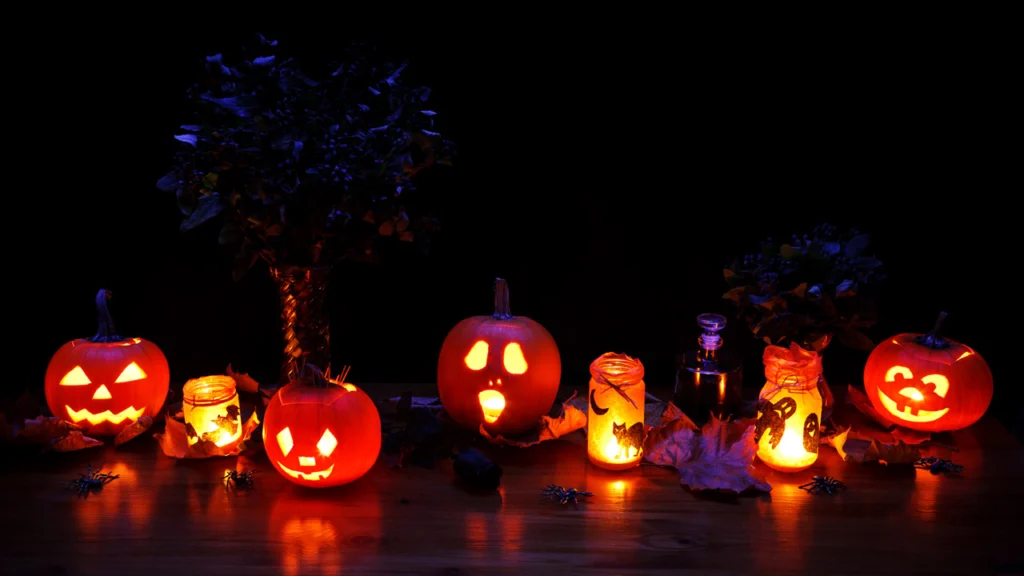Well, it’s coming up in four days, so why not give you all a brief history of Halloween, eh?

There is some debate over the origins of Halloween. Most people believe it has roots in a Celtic harvest festival named “Samhain”, that marked the end of the Celtic year and the start of the Celtic New Year.
The thing is, there was a period that night and into the next morning that didn’t quite fit the calendar; the whole festival was viewed as a transitional period where you might be able to contact ghosts and spirits from the “Other World”, as we were all technically sort of going otherworldly in a change of season.
While it may have roots in Samhain, the true Halloween – All Hallow’s Eve – did not come about until the Catholic church got involved. Or the Catholic Church invented the entire holiday; decide for yourself (Wikipedia can’t) – it’s quite obvious to me, however that Halloween has deep Celtic Harvest Festival roots.
So, in this retelling of Halloween, which I think is probably more accurate, because the Catholic Church could be very meddlesome about pagan rituals way back in those days, the Pope (Gregory III, around the year 800 — it’s unclear) announced a holiday on the day after Samhain night – November 1st – called All Saints’ Day, to honor fallen Saints and martyrs. But the Pope technically did not create Halloween, really, he basically just formed a Christian holiday around a pagan ritual to try to “civilize” people (turns out we all prefer the pagan ritual, hmm…). It was followed on November 2nd by All Souls’ Day, which commemorates any faithful departed Christian, and the three days together — All Hallows’ Eve (AKA All Saints’ Eve, but are not all Saints and martys hallowed?), All Saints’ Day, and All Souls’ Day — are known collectively as Allhallowtide.
This made the night before, October 31st, a holiday of sorts, or rather a solemn occasion. All Hallows’ Eve. Like Christmas Eve. Except the problem was the spooky element of being able to contact dead people remained (hey, they were honoring dead people in the morning, anyway). All Hallows’ Eve eventually got shortened to “Hallow’e’en”, the evening of All Hallow’s Eve. And still, for all its efforts, the Church could not lose the connection between the pagan Samhain and the supposedly “holy” All Saint’s Day — so the custom of a more traditional, spooky Halloween made it across the world as the Irish and the Scots emigrated.
The Church is sort of responsible for the rough origin of trick or treating, by the way. On All Hallows’ Eve, in Britain, Austria, Germany, those areas — up until the 1930s, people would pray desperately to get deceased loved ones out of Purgatory. Hell, they’d pray for it all the time, but the night before a holiday honoring martys and Saints? You bet. Purgatory isn’t fun. It’s not Hell, but it’s close. You stay in Purgatory and you get your sins “purged” from you (a lot of fire is involved, I think). Purgatory is where you pay for your sins. I will be there for a while, I think, if it exists. However, supposedly, if enough people pray for your soul, it can get out of Purgatory and scend to Heaven. So “soulers” used to go door to door and offer prayers for deceased relatives, and in return would receive small treats or rice cakes. It was called “souling”.
Although trick or treating originated in Ireland and Scotland (again, the Gaelic tie), the phrase “trick or treat” was not used widely in Scotland and Ireland until the 2000s. Due to the spooky Celtic roots the holiday had you’d dress up as a lost soul or a ghost and go to other people’s houses, reading out poetry, or warning of misfortune, or so on. The phrase in Scotland and Ireland was “Help the Halloween Party!” for getting goodies. It was sort of like a warped Christmas caroling session.
“Trick or treat!”, and modern trick-or-treating, does date way back to souling and soul cakes, and all that, but not the way we know it. “Trick or treat” as a saying popped up in Canada around 1917, then moved into the United States around the 1930s or so, gaining strength until the 1950s, and then reaching the modern moderate extortion treat we know it as now – give me candy or I will toilet paper your house.
The key point is the kids were already out – in guise, usually of dead people, which eventually just morphed into “something spooky” – and, being kids, they got pissed when they didn’t get treats for showing up for the “All Hallows’ Eve” bizarre form of caroling. So they felt perfectly comfortable smashing your pumpkin if you didn’t give them a Hershey’s bar.
And that is about the extent of my knowledge of Halloween – well, condensed, and hyperlinked so you can fact check it.
